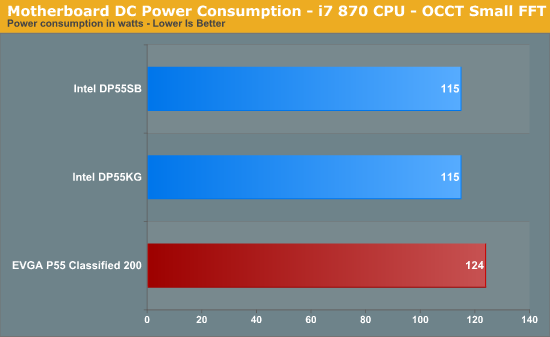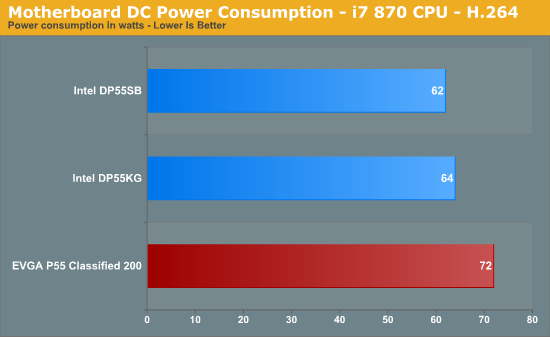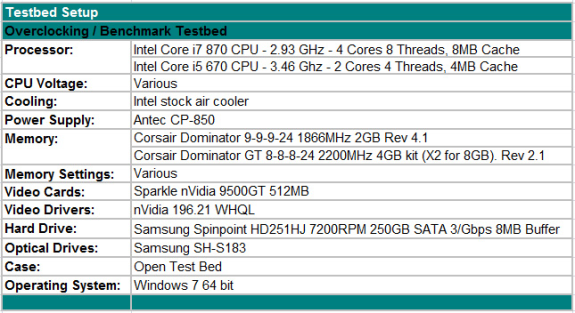Intel DP55KG and DP55SB - Two P55s Reviewed
by Rajinder Gill on April 6, 2010 7:45 PM EST- Posted in
- Motherboards
Testbed setup and power
For our test results we set up each board as closely as possible in regards to memory timings. Otherwise all other settings are left on auto. The DDR3 timings were set to 7-7-7-20 1T at DDR3-1333 for the i7-870 processor.
Power Consumption
Our power consumption testing utilizes the same batch of components under similar circumstances in a bid to monitor variances between idle and CPU load conditions. We install the vendor supplied power saving utilities on each board and enable power saving modes that don't involve any kind of underclocking or CPU core frequency modulation in order to run an apples to apples comparison.
ATX PSU switching losses are absent from our figures because we monitor power consumption directly at the DC rails of the PSU. These figures measure only the CPU, motherboard and memory DC power draw and exclude any other peripherals such as the graphics card, fans and hard drives etc. As such, AC power consumption will be anywhere from 15~40% higher than these figures depending upon the efficiency of your power supply.



The Intel boards prove to be extremely efficient in terms of power consumption, benefiting from the lack of additional features and components that the P55 Classified 200 has.











26 Comments
View All Comments
vol7ron - Tuesday, April 6, 2010 - link
If you're doing a giveaway with this... it is my birthday coming up :)vol7ron - Tuesday, April 6, 2010 - link
Is that right (8:48 4/5)? I'm not sure where it is that you're 36 hours behind me?Richard Pawley - Tuesday, April 6, 2010 - link
Hi. The article went up with the time we started putting it into the backend - It updated soon after to show when it was actually published. You must've been quick to spot that ;-)Regards,
Richard
vol7ron - Tuesday, April 6, 2010 - link
i browse AT like it's my wifeAnand Lal Shimpi - Wednesday, April 7, 2010 - link
HA! best, quote, ever.silverblue - Wednesday, April 7, 2010 - link
And here's me thinking that would mean "rarely, and only when I'm on my best behaviour"...AstroGuardian - Wednesday, April 7, 2010 - link
Welcome to the club mate ;-)What was funny was some few days ago when my wife said something like: "Stop reading that damn BLUE site of yours...". This made me laugh cause i am with AT for years longer than with her ;). Now she noticed the blue color lol
SunLord - Tuesday, April 6, 2010 - link
I love how the micro atx board literally looks like they just cut off the bottom part of the ATX board kind of coolMadMan007 - Tuesday, April 6, 2010 - link
"While the 2:6 and 2:8 memory ratios were satisfactory"So does that mean that using those ratios you can clock the bclk and CPU higher and just not get the e-peen stretching superhigh memory speeds that mostly seem to help a few synthetic benchmarks? If those ratios are 'satisfactory' and the only purpose of high memory speeds is artifical benchmarks you could focus on getting the best overall overclock and not worry about maxing out the memory speed.
I do hope you tried clocking with those ratios, perhaps the various annoyances go away or are not as bad in that case. If not I'm a little disappointed if a lot of time was spent trying to max out memory speed rather than focusing on 'real world' performance as I expect from AT.
deruberhanyok - Wednesday, April 7, 2010 - link
Thanks for the writeup! quick questions:Was the PCI-Express slot operating at x1 speed a bug only with the i5 670, or is it something in all of the Clarkdale processors until the updated BIOS comes out?
I noticed they both include a bluetooth antenna. I'm guessing the BT module is the tiny green PCB next to the SATA ports. Is that standard on all of the boards? How was reception/performance? I like the idea of not having to have an external bluetooth dongle to connect keyboards, wireless headset, cell phone, etc.